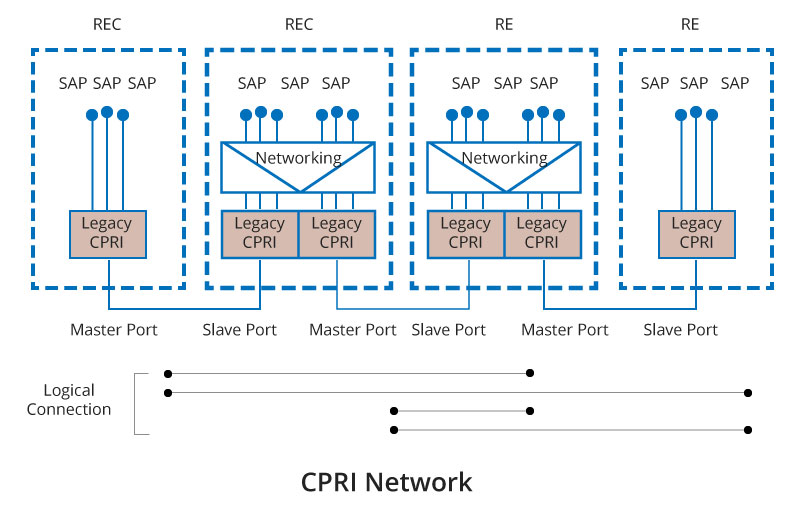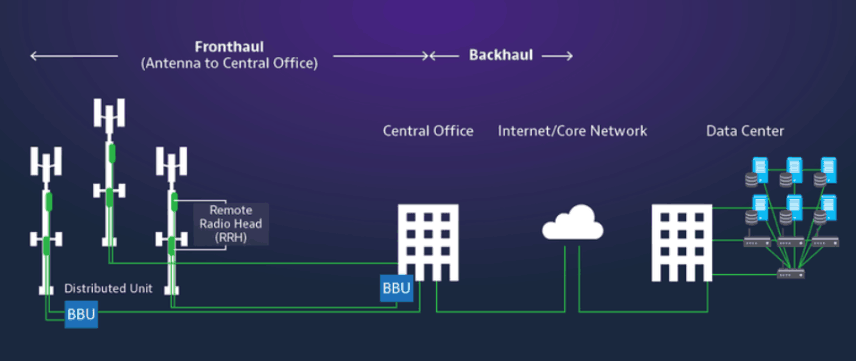CPRI vs eCPRI: What Are Their Differences and Meanings to 5G?
As 5G becomes increasingly present in our lives, the fiber between the radio units and baseband units will see an increase in traffic, which raises higher requirements for today's fiber bandwidth. CPRI and eCPRI are likely to play a prominent role in 5G networks to solve such types of problems. This post will distinguish the differences between the two protocols and their meanings to 5G.
What Are CPRI and eCPRI?
CPRI, or Common Public Radio Interface, defines key interface specification between REC (Radio Equipment Control) and RE (Radio Equipment) of radio base stations used for cellular wireless networks. It is a protocol of choice for fronthaul communications between towers and base stations (BSs) through several generations of wireless networks. CPRI has efficient and flexible I/Q data interfaces for various standards, such as GSM, WCDMA, LTE, etc.

With the introduction of new 5G applications, flexible fronthaul configurations are necessary. Issued after CPRI, eCPRI defines specifications connecting eREC and eRE via fronthaul transport network and mainly used for 5G systems, LTE-Advanced and LTE-Advanced Pro. And eCPRI can balance important components of latency, throughput, and reliability requirements for advanced 5G applications, and it is expected to be used to support 5G by enabling increased efficiency. Besides, eCPRI is an open interface, allowing carriers to work together in a more complimentary way, which can bring about better connected and faster networks across the world.

CPRI vs eCPRI: What Are Their Similarities and Differences?
Despite the similarity that both CPRI and eCPRI support functions such as redundancy, security and QoS, CPRI and eCPRI have many differences mainly in the four aspects: ports classification, supported logical connections, network nodes, 5G applicability.
Ports Classification
CPRI has master ports and slave ports. In addition, these ports can be directly connected through the optical cables or electrical cables in the CPRI. While, eCPRI does not support physical-level master or slave port classification.
Supported Logical Connections
CPRI and eCPRI support different logical connections, the latter offers one more connection than the former. CPRI supports connections from point to point (one REC with one RE) and point to multipoint (one REC with several REs). While, eCPRI supports point to point (one eREC with one eRE), point to multipoint (one eREC with several eREs) and multi-point to multi-point (several eRECs with several eREs).
Network Nodes
The topologies of network nodes in CPRI depend on REC/RE functions. in eCPRI, in addition to eRECs/eREs nodes, eCPRI nodes include transport network (fronthaul network) and other networking elements, such as GM/BC used for timing and EMS/NMS for network management.
5G Applicability
The connection between the RRH/RRU (remote radio head/unit) and the BBU (baseband unit) is often referred to as “fronthaul”. The RRUs containing antennas and some compute functionality, are often distributed every few miles in cities and suburban areas at the outer circle of a cellular network topology. The BBUs are typically distributed within approximately 10-mile circles for good coverage in populated areas.

Both CPRI and eCPRI can be used in 5G fronthaul. While, eCPRI is more suitable than CPRI in 5G fronthaul. Here are ten different network performances based on CPRI.
| CPRI Line Rate | Line Bit Rate (Gbps) | Line Coding | Bits/Word | Transport Capacity (#WCDMA AxC) | Transport Capacity (#20 MHz LTE AxC) |
|---|---|---|---|---|---|
| Rate-1 | 0.614 | 8B/10B | 8 | 4 | - |
| Rate-2 | 1.2288 | 8B/10B | 16 | 8 | 1 |
| Rate-3 | 2.4576 | 8B/10B | 32 | 16 | 2 |
| Rate-4 | 3.0720 | 8B/10B | 40 | 20 | 2 |
| Rate-5 | 4.9152 | 8B/10B | 64 | 32 | 4 |
| Rate-6 | 6.1440 | 8B/10B | 80 | 40 | 5 |
| Rate-7A | 8.1100 | 64B/66B | 128 | 64 | 8 |
| Rate-7 | 9.8304 | 8B/10B | 128 | 64 | 8 |
| Rate-8 | 10.1376 | 64B/66B | 160 | 80 | 10 |
| Rate-9 | 12.1651 | 64B/66B | 192 | 96 | 12 |
| Rate-10 | 24.3302 | 64B/66B | 384 | 192 | 24 |
From the table, we can see clearly about corresponding transport capacity under different CPRI line rates. Since 5G requires tremendous bandwidth expansion, only CPRI line rate option 10, the newest CPRI standard, can meet that requirement. However, this processing capacity has reached the upper limit of CPRI, causing doubt about whether 5G can be used stably in CPRI. What’s more, its ability to support advanced networking features is limited compared to mainstream packet transport standards. Given such a situation, eCPRI was first introduced in 2017 to directly address some of CPRI’s limitations.
eCPRI reduces latency and jitter for high-priority traffic. It improves the efficiency of 5G fronthaul networks. Compared to CPRI, eCPRI’s bandwidth requirement has been reduced tenfold and its traffic can be carried on the Ethernet along with other traffic in the same network. Additionally, eCPRI has a function splitting feature inside the PHY layer, which keeps most of the functions in the BBU. This reduces the number of radio equipment on the tower and allows faster introduction of advanced network features without the radio equipment changing.
Summary
From all the above, CPRI and eCPRI have differences in essence, especially in 5G fronthaul. Actually, eCPRI fronthaul interface is future-oriented. It optimizes radio performance by analyzing traffic and prioritizing traffic in real time using a coordination algorithm. Compared with CPRI, the eCPRI specification provides greater flexibility and reliability in positioning the functional split within the BBU physical layer. Generally speaking, CPRI is commonly used for traditional systems, while eCPRI is more suitable for 5G wireless communication technology.
You might be interested in
Email Address

-
PoE vs PoE+ vs PoE++ Switch: How to Choose?
May 30, 2024













